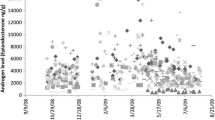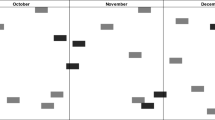Abstract
Quantitative data on the reproductive biology of Japanese monkeys (Macaca fuscata), especially of females, are reported here. Arashiyama B troop shows stable annual breeding periodicity, and has mating seasons between October and March. In mating seasons, females show estrus with rather consistent cyclicity, and are in estrus for a total of 35 days on an average. The mean length of estrous cycle is 34 days. Although most females show estrus inter-menstrually, some show peri-menstrually; i.e., estrus does not always synchronize strictly with ovulation. Pubescent females between 3.5 and 6.5 years show estrus, but with low sexual activity. Middle-aged females between 7.5 and 16.5 years show high sexual activity with high conception rate. Old-aged females over 17.5 years show low sexual activity. Females with surviving infants have lower sexual activity than those without infants. There is found no significant correlation between female's ranking and sexual activity.
Similar content being viewed by others
References
Altmann, J., 1974. Observational study of behavior: sampling methods.Behaviour, 48–49: 227–261.
Ando, A., H. Nigi, &T. Tanaka, 1976. Routine measurement of urinary estrogens of the female Japanese monkey as an index for estimating the time of ovulation.Primates, 17: 81–93.
Butler, H., 1974. Evolutional trends in primate sex cycles. In:Contributions to Primatology, Vol. 3: Reproductive Biology of the Primates,W. P. Luckett (ed), S. Karger, Basel, pp. 2–35.
Carpenter, C. R., 1942. Sexual behavior of free-ranging rhesus monkeys.J. Comp. Psychol., 33: 113–162.
Czaja, J. A. &C. Bielert, 1975. Female rhesus sexual behavior and distance to a male partner: relation to a stage of menstrual cycle.Arch. Sex. Behav., 4(6): 583–597.
Eaton, C. G., 1972. Seasonal sexual behavior; interuterine contraceptive devices in a confined troop of Japanese macaques.Hormones & Behavior, 4: 133–144.
Enomoto, T., 1974. The sexual behavior of Japanese monkeys.J. Human Evol., 3(5): 351–372.
Gordon, T. R. &I. S. Bernstein, 1974. Seasonal variation in sexual behavior of all-male rhesus troop.Am. J. Phys. Anthrop., 38: 221–226.
Hanby, J. P., 1974. Male-male mounting in Japanese monkeys (Macaca fuscata).Anim. Behav., 22: 836–849.
————,L. T. Robertson, &C. H. Phoenix, 1971. The sexual behavior of confined troop of Japanese macaques.Folia Primat., 16: 123–143.
———— &C. E. Brown, 1974. The development of socio-sexual behaviors in Japanese macaquesMacaca fuscata.Behaviour, 49(1–2): 152–196.
Kaufmann, J. H., 1965. A three-year study of mating behavior in a free-ranging band of rhesus monkeys.Ecology, 46: 500–512.
Kawai, M., 1969.Ecology of Japanese Monkeys. Kawade-shobo, Tokyo. (in Japanese)
————,S. Azuma, &K. Yoshiba, 1967. Ecological studies of reproduction in Japanese monkeys (Macaca fuscata). I. Problems of the birth season.Primates, 8: 35–74.
Kawamura, S., 1958. The matriarchal social order in Minoo-B troop: A study on the rank system of Japanese macaques.Primates, 1: 149–156. (in Japanese)
Koyama, N., 1967. On dominance rank and kinship of a wild Japanese monkey troop in Arashiyama.Primates, 8: 189–216.
————, 1970. Change in dominance rank and division of a wild Japanese monkey troop in Arashiyama.Primates, 11: 335–390.
————, 1977. The social organization of Japanese monkeys. In:Jinruigaku-koza (Anthropology), Vol. 2 (Primates),J. Itani (ed.), Yuzankaku, Tokyo, pp. 147–194. (in Japanese)
————,K. Norikoshi, &T. Mano, 1975. Population dynamics of Japanese monkeys at Arashiyama. In:Contemporary Primatology,S. Kondo,M. Kawai, &A. Ehara (eds.), S. Karger, Basel, pp. 411–417.
Loy, J., 1970. Peri-menstrual sexual behavior among rhesus monkeys.Folia Primat., 13: 286–297.
————, 1971. Estrous behavior of free-ranging rhesus monkeys (Macaca mulatta).Primates, 12: 1–31.
Masui, K., 1976. Records on the troop size and composition of the Japanese monkey (Macaca fuscata): An examination of the speculations concerning the problems of the troop size and population.Physiol. Ecol. Japan, 17: 185–194. (in Japanese)
Nigi, H., 1972. The seasonal fluctuations of reproductive functions and sexual maturity in Japanese monkey males. In:Annual Report of the Primate Research Institute, Kyoto University, Vol. 2: 43. (in Japanese)
————, 1975a. Sexual maturity of male Japanese monkeys (Macaca fuscata) in Shiga A troop.Physiol. Ecol. Japan, 16: 47–53. (in Japanese)
————, 1975b. Menstrual cycle and some other related aspects of Japanese monkeys.Primates, 16: 207–216.
————, 1976. Some aspects related to conception of the Japanese monkey (Macaca fuscata).Primates, 17: 81–87.
Nishida, T., 1977. Chimpanzees of the Mahale Mountains (1). In:Chimpanzee-ki,J. Itani (ed.), Kodan-sha, Tokyo, pp. 543–638. (in Japanese)
Norikoshi, K. &N. Koyama, 1975. Group shifting and social organization among Japanese monkeys. In:Proceedings from Symposia of the Fifth Congress of the International Primatological Society,S. Kondo,M. Kawai,A. Ehara, &S. Kawamura (eds.), Japan Science Press, Tokyo, pp. 43–61.
Stephanson, G. R., 1975. Social structure of mating activity in Japanese macaques. In:Proceedings from the Symposia of the Fifth Congress of the International Primatological Society,S. Kondo,M. Kawai,A. Ehara, &S. Kawamura (eds.), Japan Science Press, Tokyo, pp. 63–115.
Suzuki, A., K. Wada, Y. Yoshihiro, E. Tokita, S. Hara, &Y. Aburada, 1975. Population dynamics and group movement of Japanese monkeys in Yokoyugawa valley, Shiga Heights.Physiol. Ecol. Japan, 16: 15–23. (in Japanese)
Takahata, Y., in prep. a. Sociosexual behavior of Japanese monkeys.
----, in prep. b. Social relations between adult males and females in Arashiyama B troop.
Tokuda, K., 1961–2. A study on the sexual behavior in the Japanese monkey troop.Primates, 3(2): 1–40.
Wolfe, L., 1976. Sexual behavior of the Arashiyama West troop of Japanese macaques. Ph. D. Dissertation. Univ. of Oregon.
Zuckermann, S., 1932.The Social Life of Monkeys and Apes. Harcourt Brace & Co., Inc., New York.
Author information
Authors and Affiliations
Additional information
This study was financed partly by the Cooperative Research Fund of the Primate Research Institute, Kyoto University.
About this article
Cite this article
Takahata, Y. The reproductive biology of a free-ranging troop of Japanese monkeys. Primates 21, 303–329 (1980). https://doi.org/10.1007/BF02390462
Received:
Accepted:
Issue Date:
DOI: https://doi.org/10.1007/BF02390462




